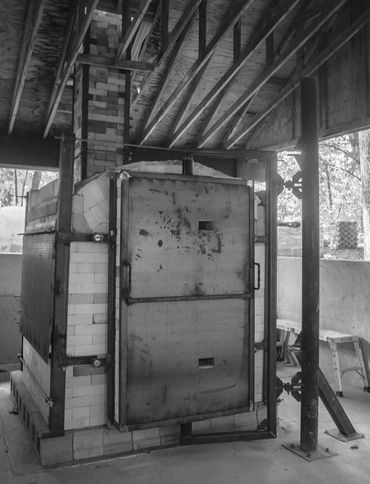Reduction Cooled
Reduction cooling refers to a step in the firing process that comes after the firing has reached peak temperature and the kiln is shut down. The kiln is tightly sealed to restrict all oxygen from entering, and as the kiln cools, the flame is slowly fed wood to extend the cooling time and encourage crystal growth and carbon trapping. Reduction cooling yields dark, crystalline, metallic surfaces with deep layers and unique patterns.
Soda Fired
Soda Firing ceramics is a process in which Sodium Carbonate or Sodium Bicarbonate is introduced into the kiln once peak temperature has been achieved. Once introduced into the kiln atmosphere, the soda ash vaporizes and reacts with the silica in the clays and glazes to help them flux, melt, and flash in unique ways.
Kiln Building
I have come to think of kiln building as a part of my process. As much as sketching, making, and firing inform my work, each unique kiln design makes a difference too. I was first introduced to kiln building under the direction of Hayun Surl at Ohio University, where together using his innovative design we built Ohio University's first gas fed Soda Firing, wood Reduction Cooling kiln deemed "The Kimchi Express." I already had a background in construction, and fell in love with the idea of making my own kiln to fire my work in. Since then I have been part of two kiln builds for Brad Schwieger at his home studio and built Nathan Goddard's cross draft wood kiln in Red Lodge, MT.



Over the Ridgeline
“What do people gain from all the toil
at which they toil under the sun?”
(Ecclesiastes 1:3)
Clay is a time capsule, a material that holds marks and gestures of the hand and flame, remembering and documenting the interactions and intentions of its surroundings. These cooperations between material and maker are perpetuated and preserved through hardening by fire. By firing my work in atmospheric kilns, I use the marks of the flame as a metaphor for remembrance of struggle and strength, while placing my work within a long history of traditional firing methods.
By using local clay, I situate my work within space and time. Each shovelful of clay harvested is unique, separating itself from the homogeneity of the supply chain and processed, factory-made materials. The wild clay used to create this work remembers the glacial melts which made it, the plants, animals, and civilizations which grew above it, and it remembers the process of hands building from it. It is a permanent reminder of this space and the histories that it has seen.
For many, this land is remembered as a life source, giving food and shelter, giving coal and clay, timber and salt. It has been a symbol of trauma, removal, and dispossession, but also of prosperity and of steadfast strength. Through strife and turmoil, the land has remained. This body of work upholds those experiences of Appalachian life, poverty, work, familiarity, and oral history, adding to the time capsule by exploring the material experience of working with and firing clay.
Over the Ridgeline realizes, signifies, and validates these histories, acknowledging and responding to the multifarious, collective memories of our connection to the land over time. The individually shaped mounds stand together in solidarity, greeting the sun as it rises and sets. We naturally look to the other side of the ridge. There, things are pristine, composed, stable. On our side of the ridge there is movement, there is change, there is uncertainty. Yet here we stand, and the hills endure.
“A generation goes, and a generation comes,
but the earth remains forever.”
(Ecclesiastes 1:4)






.jpg/:/cr=t:0%25,l:0%25,w:100%25,h:100%25/rs=w:370,cg:true)







This website uses cookies.
We use cookies to analyze website traffic and optimize your website experience. By accepting our use of cookies, your data will be aggregated with all other user data.







